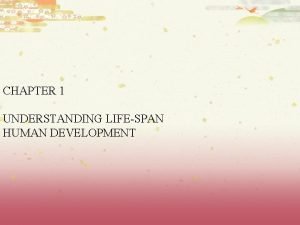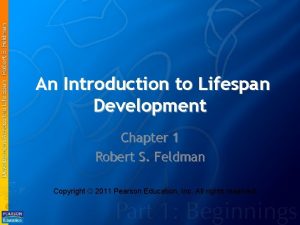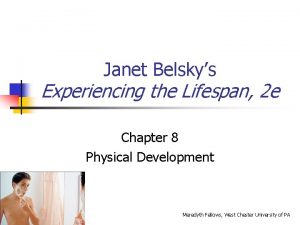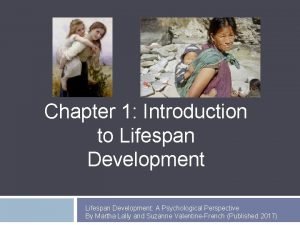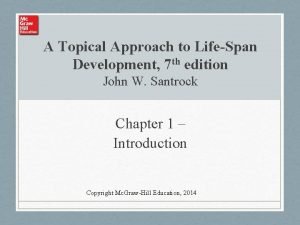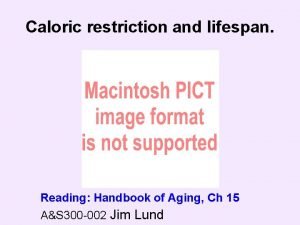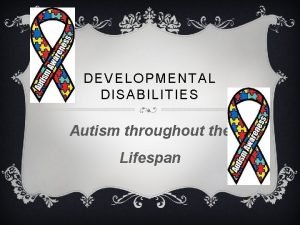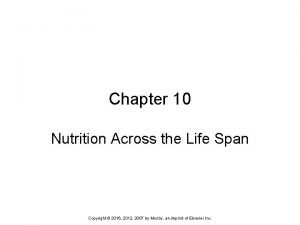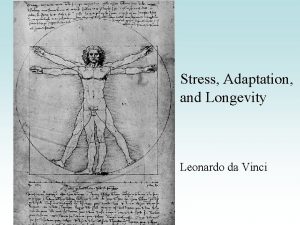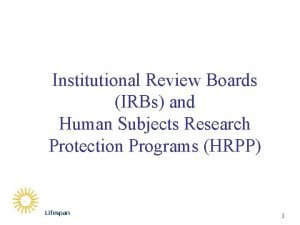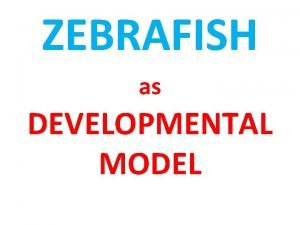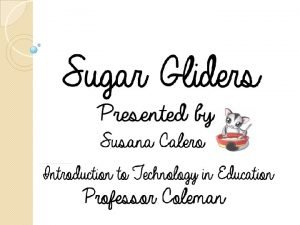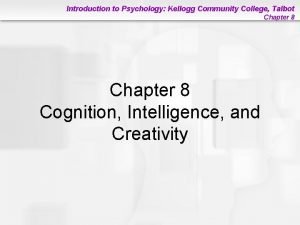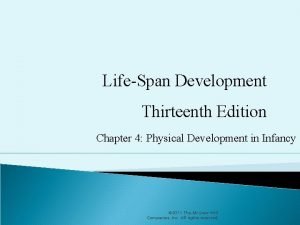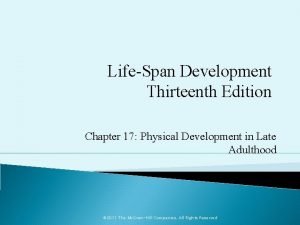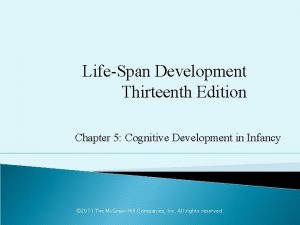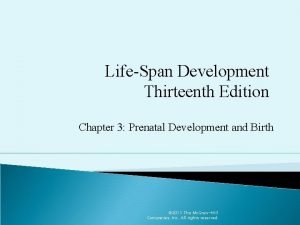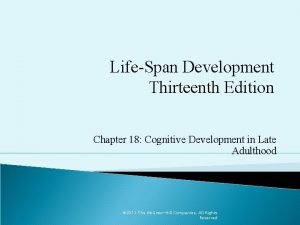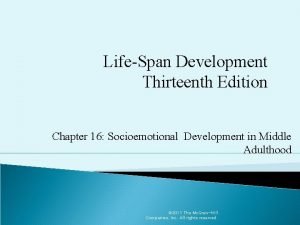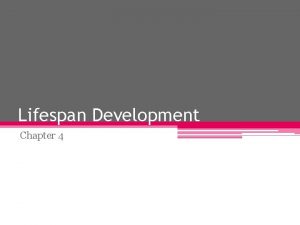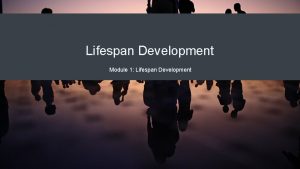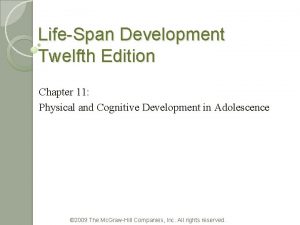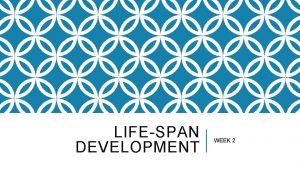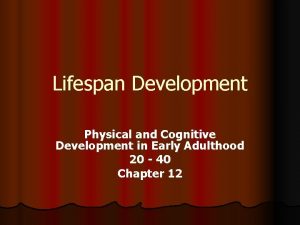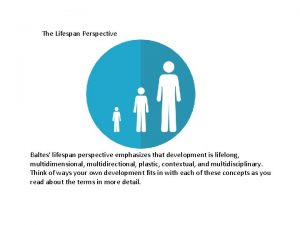LifeSpan Development Thirteenth Edition Chapter 9 Physical and


































- Slides: 34

Life-Span Development Thirteenth Edition Chapter 9: Physical and Cognitive Development In Middle and Late Childhood © 2011 The Mc. Graw-Hill Companies, Inc. All rights reserved.

Physical Changes and Health § Body Growth and Change: § Growth averages 2– 3 inches per year § Weight gain averages 5– 7 lbs. each year § Muscle mass and strength gradually increase; baby fat decreases © 2011 The Mc. Graw-Hill Companies, Inc. All rights reserved. 2

Physical Changes and Health § The Brain: § Brain volume stabilizes § Significant changes in structures and regions occur, especially in the prefrontal cortex § Increases in cortical thickness § Activation of some brain areas increase while others decrease © 2011 The Mc. Graw-Hill Companies, Inc. All rights reserved. 3

Physical Changes and Health § Motor Development: § Motor skills become smoother and more coordinated § Improvement of fine motor skills during middle and late childhood due to increased myelination of the central nervous system § Boys outperform girls in large muscle activities and girls usually outperform boys on fine motor skills © 2011 The Mc. Graw-Hill Companies, Inc. All rights reserved. 4

Physical Changes and Health § Exercise § Elementary school children need to be active § Percentage of children involved in daily P. E. programs in schools decreased from 80% (1969) to 20% (1999) § Television watching is linked with low activity and obesity in children § Exercise linked to cognitive development © 2011 The Mc. Graw-Hill Companies, Inc. All rights reserved. 5

Physical Changes and Health Exercise © 2011 The Mc. Graw-Hill Companies, Inc. All rights reserved. 6

Physical Changes and Health § Health, Illness, and Disease § Middle and late childhood is usually a time of excellent health § Accidents and Injuries § Motor vehicle accidents are most common cause of severe injury § Overweight Children § 30% of U. S. children are at risk of being overweight § Cardiovascular Disease § Uncommon in children but risk factors are present © 2011 The Mc. Graw-Hill Companies, Inc. All rights reserved. 7

Physical Changes and Health § Health, Illness, and Disease § Cancer is the 2 nd leading cause of death in children 5– 14 years old § Most common child cancer is leukemia § Children with cancer are surviving longer because of advancements in cancer treatment © 2011 The Mc. Graw-Hill Companies, Inc. All rights reserved. 8

Physical Changes and Health, Illness, and Disease © 2011 The Mc. Graw-Hill Companies, Inc. All rights reserved. 9

Children With Disabilities © 2011 The Mc. Graw-Hill Companies, Inc. All rights reserved. 10

Children With Disabilities § The Scope of Disabilities § Learning Disabilities § Difficulty in learning that involves understanding or using spoken or written language, and the difficulty can appear in listening, thinking, reading, writing, and spelling § Boys are identified three times more frequently than girls § Dyslexia, dysgraphia, and dyscalculia are most common © 2011 The Mc. Graw-Hill Companies, Inc. All rights reserved. 11

Children With Disabilities § The Scope of Disabilities § Attention deficit hyperactivity disorder (ADHD) § Characterized by inattention, hyperactivity, and impulsivity § Number of children diagnosed has increased substantially § Possible Causes § § Genetics Brain damage during prenatal or postnatal development Cigarette and alcohol exposure during prenatal development Low birth weight © 2011 The Mc. Graw-Hill Companies, Inc. All rights reserved. 12

Children With Disabilities § The Scope of Disabilities § Emotional and Behavioral Disorders § Serious, persistent problems that involve relationships, aggression, depression, and fears associated with personal or school matters, as well as other inappropriate socioemotional characteristics § Autism Spectrum Disorders (ASD) § Autistic disorder to Asperger syndrome § Appears to be a brain dysfunction © 2011 The Mc. Graw-Hill Companies, Inc. All rights reserved. 13

Children With Disabilities § Educational Issues: § 1975: all public schools required to serve disabled children § Law requires disability students to receive: § IEP (Individualized Education Plan): written statement that is specifically tailored for the disabled student § LRE (Least Restrictive Environment): a setting that is as similar as possible to that of non-disabled children § Inclusion: educating a child with special education needs in the regular classroom © 2011 The Mc. Graw-Hill Companies, Inc. All rights reserved. 14

Cognitive Changes § Piaget’s Cognitive Developmental Theory § Concrete Operational Stage: Ages 7 to 11 § Children can perform concrete operations and reason logically, and are able to classify things into different sets § Seriation: the ability to order stimuli along a quantitative dimension § Transitivity: the ability to logically combine relations to understand certain conclusions © 2011 The Mc. Graw-Hill Companies, Inc. All rights reserved. 15

Cognitive Changes § Information Processing § Memory: long-term memory increases with age during middle and late childhood § Knowledge and Expertise § Experts have acquired extensive knowledge about a particular content area § Strategies § Fuzzy Trace Theory © 2011 The Mc. Graw-Hill Companies, Inc. All rights reserved. 16

Cognitive Changes § Information Processing § Thinking § Critical Thinking: thinking reflectively and productively, and evaluating evidence § Mindfulness § Creative Thinking: the ability to think in novel and unusual ways, and to come up with unique solutions to problems § Convergent thinking vs. Divergent thinking © 2011 The Mc. Graw-Hill Companies, Inc. All rights reserved. 17

Cognitive Changes § Information Processing § Metacognition: cognition about cognition § Metamemory: knowledge about memory § Children have some knowledge of metamemory by 5– 6 years of age § Scientific Thinking: § Asking fundamental and identifying causal relations questions about reality © 2011 The Mc. Graw-Hill Companies, Inc. All rights reserved. 18

Cognitive Changes § Intelligence § Ability to solve problems and to adapt and learn from experiences § Binet Tests: designed to identify children with difficulty learning in school § Mental age (MA): an individual’s level of mental development relative to others § Intelligence quotient (IQ): a person’s mental age divided by chronological age, multiplied by 100 § Stanford-Binet Tests: revised version of the Binet test § Scores approximate a normal distribution—a bell-shaped curve § Wechsler Scales: give scores on several composite indices § Three versions for different age groups © 2011 The Mc. Graw-Hill Companies, Inc. All rights reserved. 19

Cognitive Changes Intelligence © 2011 The Mc. Graw-Hill Companies, Inc. All rights reserved. 20

Intelligence Wechsler Intelligence Scale for Children (WISC) © 2011 The Mc. Graw-Hill Companies, Inc. All rights reserved. 21

Cognitive Changes § Intelligence § Types of Intelligence: § Sternberg’s Triarchic Theory of Intelligence § Analytical intelligence: ability to analyze, judge, evaluate, compare, and contrast § Creative intelligence: ability to create, design, invent, originate, and imagine § Practical intelligence: ability to use, apply, implement, and put ideas into practice © 2011 The Mc. Graw-Hill Companies, Inc. All rights reserved. 22

Cognitive Changes § Intelligence § Types of Intelligence (continued): § Gardner’s Eight Frames of Mind: § Verbal: ability to think in words and use language to express meaning § Mathematical: ability to carry out mathematical operations § Spatial: ability to think three-dimensionally § Bodily-Kinesthetic: ability to manipulate objects and be physically adept § Musical: sensitivity to pitch, melody, rhythm, and tone § Interpersonal: ability to understand interact effectively with others § Intrapersonal: ability to understand oneself § Naturalist: ability to observe patterns in nature and understand natural and human-made systems © 2011 The Mc. Graw-Hill Companies, Inc. All rights reserved. 23

Cognitive Changes § Intelligence § Evaluating Multiple-Intelligence Approaches: § Stimulated teachers to think more broadly about children’s competencies § Contributed to interest in assessing intelligence and classroom learning § Research has not yet supported the different types © 2011 The Mc. Graw-Hill Companies, Inc. All rights reserved. 24

Cognitive Changes § Interpreting Differences in IQ Scores § Influences of Genetics: § Environmental Influences § Group Differences § Creating Culture-Fair © 2011 The Mc. Graw-Hill Companies, Inc. All rights reserved. 25

Differences in IQ Scores © 2011 The Mc. Graw-Hill Companies, Inc. All rights reserved. 26

Differences in IQ Scores © 2011 The Mc. Graw-Hill Companies, Inc. All rights reserved. 27

Differences in IQ Scores © 2011 The Mc. Graw-Hill Companies, Inc. All rights reserved. 28

Cognitive Changes § Intelligence § Using Intelligence Tests: § Avoid stereotyping and expectations § Know that IQ is not the sole indicator of competence § Use caution in interpreting an overall IQ score © 2011 The Mc. Graw-Hill Companies, Inc. All rights reserved. 29

Cognitive Changes § Extremes of Intelligence: § Mental Retardation: a condition of limited mental ability in which an individual has a low IQ (typically below 70) and has difficulty adapting to everyday life § Can be mild, moderate, or severe § Organic retardation and Cultural-familial retardation © 2011 The Mc. Graw-Hill Companies, Inc. All rights reserved. 30

Cognitive Changes § Extremes of Intelligence (continued): § Giftedness: people who have 130 IQ or higher and/or superior talent for something § Three criteria: § Precocity § Marching to their own drummer § A passion to master © 2011 The Mc. Graw-Hill Companies, Inc. All rights reserved. 31

Language Development § Vocabulary, Grammar, and Metalinguistic Awareness § During middle and late childhood, changes occur in the way children’s mental vocabulary is organized § Similar advances in grammar skills § Metalinguistic Awareness: knowledge about language § Improves significantly during elementary school years © 2011 The Mc. Graw-Hill Companies, Inc. All rights reserved. 32

Language Development § Reading: § Two approaches to teaching reading: § Whole-language approach vs. Phonics approach § Writing § Parents and teachers should encourage children’s early writing but not be concerned with the formation of letters or spelling © 2011 The Mc. Graw-Hill Companies, Inc. All rights reserved. 33

Language Development § Bilingualism and Second-Language Learning § Proficiency in learning a second language is a complex topic § U. S. students behind other countries § Bilingualism has a positive effect on children’s cognitive development § Bilingual Education § Pros and cons – however, research supports bilingual education © 2011 The Mc. Graw-Hill Companies, Inc. All rights reserved. 34
 Development through the lifespan 6th edition
Development through the lifespan 6th edition Lifespan development third edition
Lifespan development third edition Lifespan development third edition
Lifespan development third edition Openstax
Openstax Physical development
Physical development Exploring lifespan development chapter 1
Exploring lifespan development chapter 1 Exploring lifespan development chapter 1
Exploring lifespan development chapter 1 Janet belsky
Janet belsky Ul guidance counselling
Ul guidance counselling Discontinuous development psychology
Discontinuous development psychology A topical approach to lifespan development
A topical approach to lifespan development Mis chapter 6
Mis chapter 6 Using mis 10th edition
Using mis 10th edition Life cycle of a leopard
Life cycle of a leopard Gulper eel habitat
Gulper eel habitat Petit fours bases
Petit fours bases Splendour beetle
Splendour beetle Bee larvae stages
Bee larvae stages Juan ponce de leon lifespan
Juan ponce de leon lifespan Henry hudson lifespan
Henry hudson lifespan Lifespan of every animal
Lifespan of every animal The developing person through the lifespan
The developing person through the lifespan Prairie dog adaptations
Prairie dog adaptations Autism lifespan
Autism lifespan Nutrition across life stages
Nutrition across life stages Longest lifespan
Longest lifespan Da vinci lifespan
Da vinci lifespan Lifespan irb
Lifespan irb Henry hudson lifespan
Henry hudson lifespan Economic importance of physalia
Economic importance of physalia Lifespan of platelets
Lifespan of platelets La vecchio
La vecchio Zebrafish lifespan
Zebrafish lifespan Can sugar gliders eat beets
Can sugar gliders eat beets What are the barriers to problem-solving in psychology
What are the barriers to problem-solving in psychology





